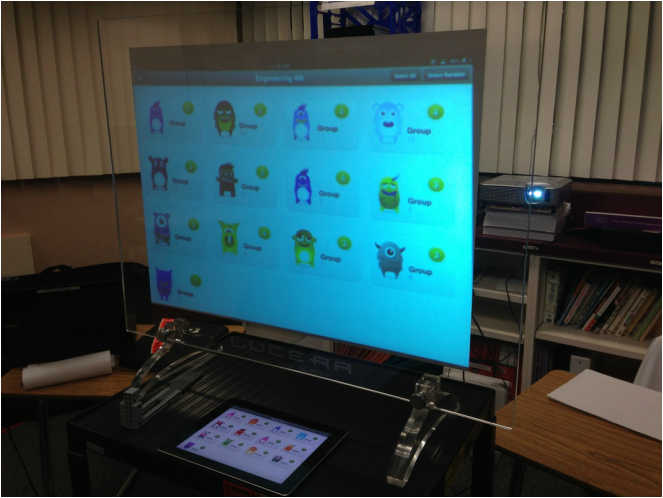As a student in my credential program, I was introduced to the Mount Rushmore of educational theory.
Since Gardner's work has been published and embraced (and now one of the most pivotal pieces of research regarding education and brain theory), education has been transformed for the better. The problem has been that, given a class of 35 students who all learn using a variety of Gardner's 7 identified intelligences, how can a teacher truly reach all of the students in the room at the same time using the same lesson? The answer to this, resoundingly since the research was released, has been "I just don't have enough time". This is such a fair and accurate response. Maybe on a formal evaluation day, but not on a daily basis - until technology became available in the manner that it has today.
Howard Gardner, I hope you're smiling!
Friday, our lesson was talking about slope and using two points to find the slope of a line (Standard 6.0 of the California State Algebra Standards). This was a perfect opportunity to roll out as many different intelligences as I possibly could think of. When it was all said and done, I had built in 6 with an inference to the 7th...
Visual-Spatial
During this portion of the lesson, students were able to get visuals that represented various slopes of lines seen in nature and have discussions about them. Taking each of these visuals into context, students were asked to think about how easy it would be to walk across the given line with no assistance whatsoever (no climbing gear, just walking!). Using the iPad Prezi Viewer, students are able to go through the presentation at their own pace and get a good understanding of the pictures and the different ways of writing slope. There is also an embedded YouTube video of additional instruction for students who need it.
This section of the lesson also reached the logical-mathematical group to some extent (so did the practice problems, but those are no fun to talk about)
Interpersonal
For these students, we had a discussion about each one of the pictures above. How easy would it be to walk across each line presented? The answers varied, but the interpersonal student buried in each group was more than happy to chip in their rendition of the answer. It wasn't an unstructured conversation about a slew of problems. On the contrary, these were brief, focused, mini-conversations about the task at hand.
Kinesthetic
If you want to help these students learn in their own environment, give them something to do! With the iPad, this is a simple task. For this lesson, two students were asked to go around campus to find an example of the four different types of slope. As you can see in the video below, the proof of understanding took 17 seconds from the video and a total of 10 minutes for them to complete. In that same amount of time, those two students were on a mission to find these four examples and did so flawlessly.
Musical
The musical students in the class are currently being tasked with the objective of creating a song to remember the slope formula. This is something new to students when they get into 8th grade and something that is very difficult to memorize. Using the iPad apps iMovie and Notes Plus, students are in the process of creating their lyrics and video for their unique rendition of a song to remember the slope formula. Be sure to check out my Algebra page for updates as they come! This is also good for the linguistic student, kinesthetic student, and interpersonal student.
(As a side note, this is being done on the students' own time due to me not having enough iPads in the room for them to work on it during class).
While you wait for that, check out a previous group's work on exponent rules below:
Intrapersonal
During the lesson on slope, we finished up with the Prezi and got into a few examples. The students were responsible for finding the slope of a line given two points. Simple enough, and usually it would be followed up with randomized questioning, Think-Pair-Share, and other instructional strategies that allowed students to interact with each other. Unfortunately, these students have no desire to. Instead, we used a Web 2.0 tool called TodaysMeet. This is a website that allows the instructor to create a FREE chatroom on the fly for a determined period of time (for my class, I set them up for 12 hours). Within this chatroom, even the most introverted student can freely respond to a given question presented to the class. Not only is TodaysMeet easy to use for the intrapersonal student, but it can also be used to check for understanding in a 1:1 or BYOD setting immediately.
Linguistic
Using the iPad with the Educreations app, students were able to stand up and explain how they got the solutions to each of the problems that were presented. Not only did the linguistic students get a chance to say what they knew, but the entire class filled with intrapersonal and auditory learners were able to get support as well.
For those of you who are watching the video above and wondering about the screen that I am using, it is called Lucera. The screen is an incredibly thin and very light rear-projection screen that has no moving parts and is a new product that is sure to be showing up in classroom all around the world. If you are interested in learning more about the product, please email me! I have been using it in my room for the past 3 days and my students absolutely love it. The screen is fairly small, but I'm overwhelmed by how many students can see the board clearly from anywhere in the room. There is minimal glare, even though the video doesn't show that in action.
I have also been using the Lucera screen in conjunction with Class Dojo, a hilarious app that allows your students to see how many points they are gaining or losing based on a large list of options. I have my students separated into groups and, as the class period carries on, I can easily award points for a group working well or dock points for groups that are off task. During the lesson, simply swipe between your presentation or instruction and Class Dojo to keep the students engaged and updated about the points they have earned or lost for the class period. Even for 8th graders, this is a great resource (and FREE)!!!









 RSS Feed
RSS Feed
